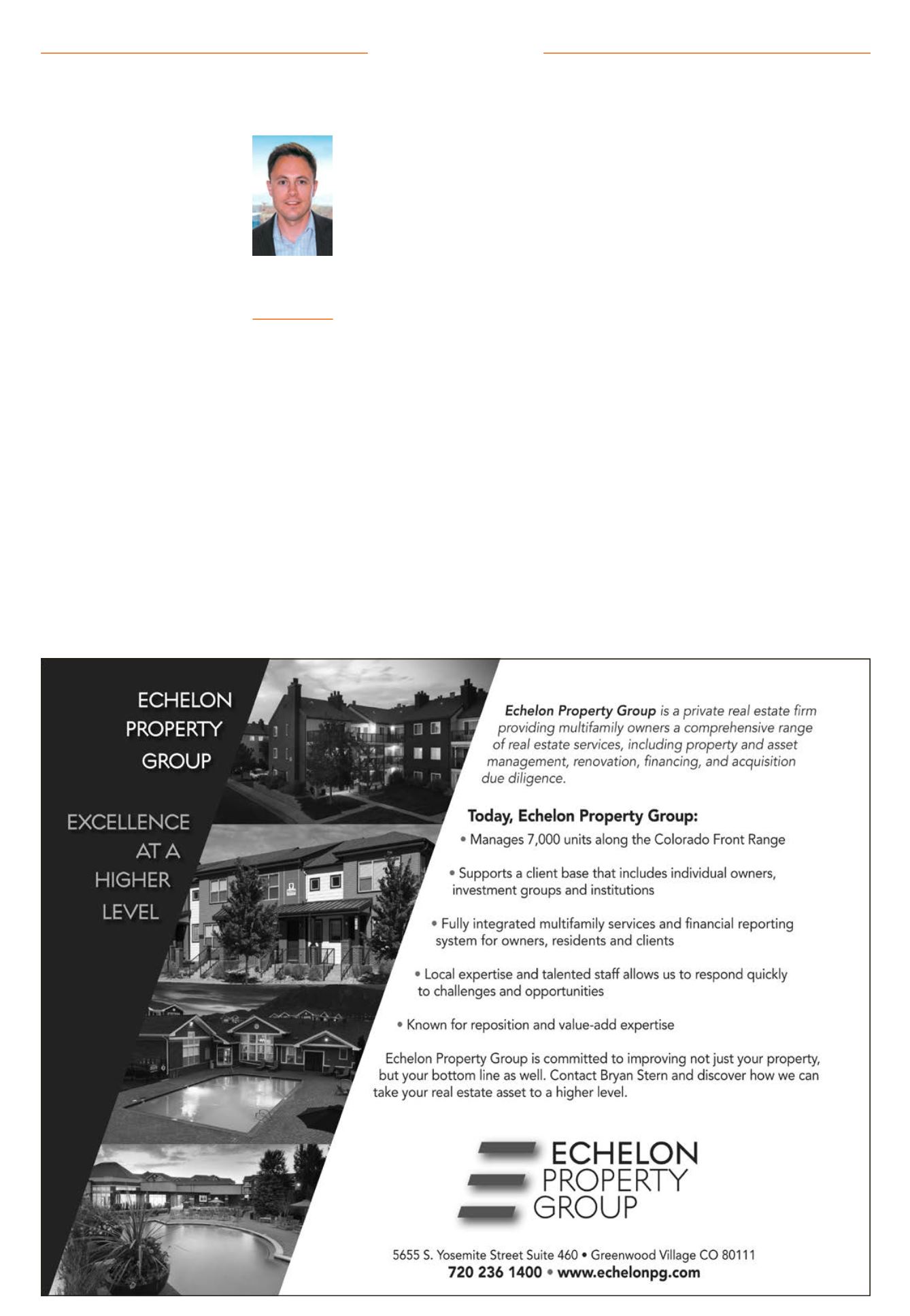

Page 16
— Multifamily Properties Quarterly — January 2015
O
f late, one of the main ques-
tions that seems to always
come up in conversations
regarding the state of Den-
ver’s apartment market is,
“How long can the market continue
to thrive before hitting the inevi-
table wall?” It’s an interesting ques-
tion that deserves to be addressed.
When looked at through the prism
of the current context, the rel-
evance of the observation becomes
a discussion of what the city of
Denver is evolving into, in contrast
to what Denver has always seemed
to be. Denver historically has been
considered a relatively traditional
town, and a place where things,
for the most part, stayed the same.
That old school, “cow town” mind-
set is now truly a thing of the past.
Denver is evolving from the baby
boomer capital of the U.S. into one
of the youngest cities in the coun-
try, bringing with it a rejuvenated
and reinvented outlook on what
today’s residents consider impor-
tant when it comes to how and
where they live as well as why.
Yes, there is a historic amount
of new product being delivered, at
rents that would have been con-
sidered unrealistic to those living
in Denver 10 years ago. But look at
how and where Denver has grown
in those 10 years. For those of us
who have called Denver home for
the past decade, I ask: Would you
have picked the Highland neighbor-
hood as an area you would have
lived in 10 years
ago? What about
the Baker neigh-
borhood? Five
Points? River North
Industrial District?
I argue the answer
is probably no.
Now, fast forward
to today. The High-
lands, especially
if you were newly
graduated from
college and single?
RiNo, which now
houses some of
the top socials venues in the city?
Umm, yes please. And you would
pay an accepted premium to live in
those areas today because the price
is well worth the location.
Denver is now one of the younger
cities in the country, and it con-
tinues to get younger, and these
younger residents rent. According to
the U.S. Census Bureau, the median
resident age in Denver has fallen to
33.7, a stark contrast to the median
age of the U.S. at 37.6.
Let’s also not forget that Denver
has become the beer capital of the
U.S., and enjoys all four seasons,
while still being able to boast 300
days of sunshine per year. Den-
ver and the surrounding markets
always have been some of the best
places to live; it just so happens
that now, the rest of the county
knows this and people are flocking
to the Mile High City.
In an October 2014 article in the
New York Times titled, “Where
Young College Graduates are Choos-
ing to Live,” Denver was listed as
third in the country, nearly doubling
that of the national average. This
continually increasing influx of col-
lege grads has had a twofold effect
on Denver: One, it has made Denver
a much younger city, and two, Den-
ver now can boast that it is one of
the most highly educated cities in
the country. During the depths of
the Great Recession, Denver contin-
ued to see its population increase
even as employers were downsiz-
ing. The most common response to
why someone would move to Den-
ver without a job was, “If I’m going
to be unemployed, I might as well
be unemployed in a place where I
want to live.”
This widespread mentality did
not fall on deaf ears. With a young,
highly educated workforce comes
employers and job growth. Employ-
ers took note of the trends in popu-
lation and identified the metro as
a core area to establish a presence
and consider expansion of exist-
ing operations, as well as looking to
establish their presence. Denver’s
current growth cycle is experienc-
ing both. This is attracting younger,
educated residents, who then look
to rent. Denver is a city that offers
both a high quality of life and one
of the top metropolitan areas in
the country to find a job and start a
career. This combination will keep
perpetuating the success that Den-
ver’s apartment market has experi-
enced over the past three years.
The mentality of today’s resident
is vastly different than 10 years
ago. Aside from the high barriers
to entry for homeownership in the
metro area, which is simply not an
option for many, how people view
lifestyle is vastly different as well.
The average person is now get-
ting married later in life, therefore
staying single longer. The average
couple is choosing to start a family
later in life. Both of these factors
denote a trend away from owner-
ship and toward renting. Accord-
ing to the Metro Denver Economic
Development Corp., residents rang-
ing from 18 to 35 years old in 2014
made up nearly 22 percent of the
total population for the metro
area, equating to roughly 800,000
residents. In comparison, the total
base of apartment units today is
approaching 300,000. I argue that
Denver will not be looking at a soft-
ening apartment market after new
product hits lease-up. Instead, I see
a market that continues to prosper
for a number of years. Will we see
year-over-year rent growth main-
tain 10 percent to12 percent, as it
has for the last 36 months? Prob-
ably not, but I argue that vacancies
will remain compressed even with
the high volume of construction
and new deliveries.
s
Why apartments will continue to flourish in DenverMarket Driver
Andy Hellman
Associate, ARA
Real Estate
Investment
Services, Denver
















